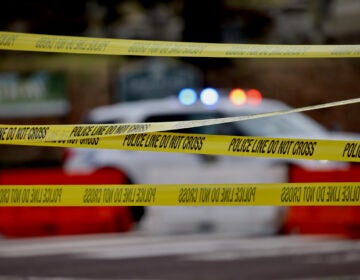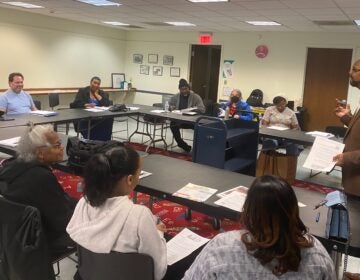A patchwork history; learning about the past through quilts
Everyone in the room wore white linen gloves lest the oils from their hands change history.
In the world of centuries old hand made quilts small things make a big difference. Purple fades to brown with 300 years behind it, other fabric dyes go rust-red when unfolded in the open air. And the stitching, pattern design, color combinations and overall shapes that make up these old bed coverings can mean an origin in colonial times, or the Revolutionary era, Pennsylvania German Mennonite roots or Pennsylvania English Quaker tradition.
Twenty one women, and one man, leaned over the broad table at the Germantown Historical Society last weekend and examined the quilt collections held by GHS, Wyck and Stenton to learn more about Philadelphia history.
Each quilt was carefully opened and the attendees gathered around. Like the 93 inch by 108 inch silk friendship quilt that was made by Margaret Williams in 1855.
Linda Eaton, director of collections and senior curator of textiles at Winterthur Museum, and Barb Garrett, a quilt historian from Chester County, explained how the quilts told a stories about the people who made them. Margaret Williams’ friendship quilt featured LeMoyne stars, inked signatures and ribbon binding.
“It’s an Orthodox Quaker quilt,” Eaton said. “Where you’re placed on the quilt is indicative of how close you are to the person in the star.”
The experts picked out the quilts based on condition and visual appeal. They also wanted to show a variety of types, Garrett said.
The former math teacher leans toward a quilt that resembled geometric shapes. It was never finished, but she thought it was important to include just quilt tops as well.
“It is just a top, but all quilts started off as tops,” she said.
The quilts ranged from the 1700s to the early 1900s, but sometimes Linda Eaton would disagree with the given dates because of the fabrics, colors or patterns used. One, a pieced lone star thought to be from at least 1830 was most likely from the early 1840s because the colors were mineral-based dyes, she said.
A quilt with a log cabin image that was made of velvet with a silk embroidery helped put Revolutionary era history into context. It dated to the 1880s, when Patterson, New Jersey and Connecticut were the leaders of silk manufacturing. So it is likely the silk came from the United States, Eaton said.
The attendees, most of whom are quilters, would also chime in with their own opinions and facts.
Connecting with other people is what drew Gay Johnson to the event. She likes to interact with other quilters and describes the activity as artistic and social. She doesn’t make quilts anymore, but she knows how absorbing it can be.
“Making a quilt takes a lot of time and a lot of space,” Johnson said. “You kind of have to plan your life around it.”
Pat and Arlan Christ have dedicated the last 10 years to studying quilts.
The Christs have amassed close to 600 quilts, which are stored in their temperature-controlled basement. They attended the event to see the various fabrics, some of which are older than the 1830s quilts they own.
Studying quilts can be like piecing together any historical mystery, sometimes there are red herrings. Just like the experts said, the Christs have learned that going by the name on a quilt is not always right.
“We have a quilt with a name on it,” Pat said. “But she wasn’t even a quilter. It was hers and she put her name on it.”
WHYY is your source for fact-based, in-depth journalism and information. As a nonprofit organization, we rely on financial support from readers like you. Please give today.




